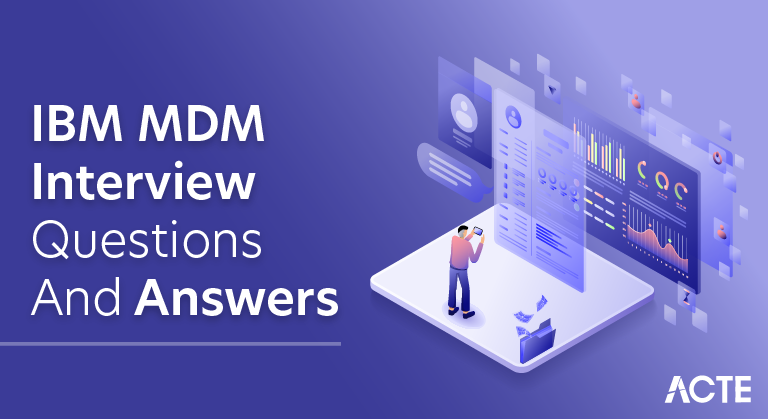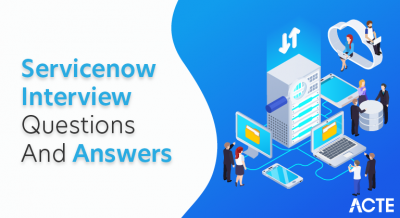
These IBM MDM interview questions have been specifically crafted to familiarize you with the types of questions that may arise during your interview on the topic of IBM Master Data Management. In my experience, adept interviewers often begin with fundamental concepts and then proceed based on the candidate’s responses, fostering a more dynamic and insightful discussion. This compilation encompasses the top IBM MDM interview questions, offering comprehensive answers. It spans scenario-based questions, queries suitable for freshers entering the field, and those tailored for experienced professionals in the realm of IBM MDM.
1. What is IBM Master Data Management (MDM)?
Ans:
- IBM Master Data Management (MDM) serves as a comprehensive solution that empowers organizations to centralize and manage critical business data.
- Functioning as a centralized hub, it ensures the accuracy, consistency, and reliability of master data across various applications and processes.
- This strategic approach to data management allows organizations to create a unified and trustworthy foundation for decision-making.
2. How does IBM MDM contribute to data quality improvement?
Ans:
- IBM MDM significantly enhances data quality by establishing a centralized repository for master data.
- Within this repository, data governance policies are implemented and enforced, leading to the standardization of data formats and the elimination of inconsistencies.
- Through these measures, IBM MDM systematically raises the overall quality of data across the organization, fostering trust in the accuracy of information used for critical business operations.
3. What are the key components of IBM MDM?
Ans:
- IBM MDM comprises several integral components.
- The MDM Hub functions as the central repository, housing master data, while connectors facilitate seamless integration with diverse data sources.
- Data governance tools are critical for enforcing norms and standards, and user interfaces for data stewardship and management are given.
- These components work together to provide a strong ecosystem for successful master data management, assuring data consistency and dependability.
4. How does IBM MDM handle data integration across different systems?
Ans:
- IBM MDM tackles data integration challenges by leveraging connectors and adapters.
- These components enable the integration of master data seamlessly with various data sources and applications.
- This approach ensures that data synchronization occurs efficiently, maintaining consistency across different systems and platforms within the organization.
5. What role does data governance play in IBM MDM?
Ans:
- Data governance is a cornerstone of IBM MDM, playing a pivotal role in defining and enforcing policies, standards, and procedures for master data management.
- It establishes a framework for data stewardship, ensuring that data is accurate, complete, and aligned with organizational regulations.
- Through robust data governance, IBM MDM empowers organizations to maintain data integrity and compliance.
6. Explain the concept of golden record in IBM MDM.
Ans:
- The golden record in IBM MDM signifies the ultimate, authoritative version of master data.
- This consolidated and cleansed representation ensures a single, accurate view of information across the organization.
- The golden record serves as a reliable reference point, promoting consistency and trust in data-driven decision-making processes.
7. How does IBM MDM handle data security and privacy?
Ans:
- IBM MDM prioritises data security and privacy through a multidimensional strategy.
- To protect important master data, robust security mechanisms such as access limits, encryption, and audits are in place.
- This not only guards against unauthorised access but also assures compliance with data protection requirements, establishing IBM MDM as a safe and trustworthy data management solution.
8. What challenges does IBM MDM address in a business environment?
Ans:
- IBM MDM effectively addresses several critical challenges prevalent in business environments.
- It mitigates data inconsistency by providing a centralized repository and streamlining data management processes.
- Additionally, it reduces errors and enhances operational efficiency by enforcing data quality rules.
- By tackling these challenges, IBM MDM creates a foundation for organizations to leverage accurate and reliable data for informed decision-making.
9. How does IBM MDM support master data consolidation?
Ans:
- IBM MDM supports master data consolidation by identifying and resolving duplicate records, standardizing data formats, and creating a centralized repository—the MDM Hub.
- Through these processes, it ensures that master data is consistent, accurate, and maintained as a single, authoritative source throughout the organization.
10. Explain the relationship between IBM MDM and data governance?
Ans:
- The relationship between IBM MDM and data governance is symbiotic.
- IBM MDM relies on data governance principles to define and enforce rules for managing master data effectively.
- Data governance, in turn, finds a practical application within IBM MDM by ensuring that organizational policies and compliance requirements are met during the entire lifecycle of master data.
11. What role does MDM play in customer relationship management (CRM)?
Ans:
- In CRM, IBM MDM plays a transformative role by ensuring that customer information remains consistent and accurate across various touchpoints.
- By creating a unified view of customer data, IBM MDM enhances customer relationship management, contributing to improved customer service and more effective decision-making processes.
12. How does IBM MDM handle data quality monitoring and reporting?
Ans:
- IBM MDM incorporates robust tools for data quality monitoring and reporting.
- Through intuitive dashboards and reports, organizations gain insights into data quality, identifying discrepancies and trends.
- This proactive approach allows data stewards to address issues promptly, maintaining high data quality standards across the organization.
13. How does IBM MDM handle data lineage and auditing?
Ans:
- IBM MDM maintains a comprehensive record of data lineage, documenting the origin and evolution of master data.
- This historical perspective is crucial for auditing purposes, ensuring transparency and accountability.
- The integration of data lineage and auditing features enhances compliance efforts and provides organizations with a clear understanding of data modifications over time.
14. How does IBM MDM manage cross-domain master data for organizational consistency and interoperability?
Ans:
| Aspect | Batch Processing | Real-Time Processing | |
| Data Update Frequency |
Periodic and scheduled updates |
Continuous and immediate updates | |
| Latency | Typically higher latency due to scheduled updates | Minimal latency, ensuring near real-time data accuracy | |
| Data Consistency | May experience temporary inconsistencies between updates | Ensures consistent and synchronized data in real-time | |
| Scalability |
Generally easier to scale with batch processing |
May face challenges in scaling due to real-time constraints |
15. How does IBM MDM facilitate cross-domain master data management?
Ans:
- IBM MDM facilitates cross-domain master data management by enabling organizations to manage different types of master data—such as customer, product, and employee data—within a unified system.
- This approach promotes a holistic view of data, enhancing consistency and interoperability across diverse domains.
16. What are the deployment options for IBM MDM?
Ans:
- IBM MDM offers flexible deployment options, catering to diverse organizational needs.
- Organizations can choose between on-premises and cloud-based deployments based on their IT infrastructure, scalability requirements, and overall business objectives.
17. How does IBM MDM handle data synchronization in real-time scenarios?
Ans:
- IBM MDM enables real-time data synchronisation via event-driven processes and messaging systems.
- Changes to master data in one system are immediately reflected in connected systems, ensuring that data is consistent and up-to-date across the organisation in real-time.
18. What is the role of data stewards in IBM MDM?
Ans:
- Data stewards in IBM MDM play a crucial role in managing and ensuring the quality of master data.
- They utilize the MDM interface to review, resolve data issues, enforce data governance policies, and collaborate with business users.
- The proactive involvement of data stewards is essential for maintaining data accuracy and reliability.
19. How does IBM MDM support multi-domain master data management?
Ans:
- IBM MDM supports multi-domain master data management by allowing organizations to manage and consolidate master data across different domains.
- This capability enables a unified approach to data management, fostering consistency and a comprehensive understanding of various master data entities.
20. What is the impact of IBM MDM on regulatory compliance?
Ans:
- IBM MDM significantly impacts regulatory compliance by enforcing data governance policies, maintaining accurate records, and providing robust audit trails.
- This ensures that master data aligns with regulatory standards, making it a critical tool for organizations aiming to meet compliance requirements.
21. Can IBM MDM integrate with third-party applications and systems?
Ans:
- Yes, IBM MDM is designed to seamlessly integrate with third-party applications and systems.
- This flexibility is achieved through the use of connectors and adapters, allowing organizations to leverage MDM functionalities within their existing IT landscape.
22. How does IBM MDM handle data migration and onboarding of new data sources?
Ans:
- IBM MDM streamlines data migration and the onboarding of new data sources by providing tools and processes.
- These tools facilitate the mapping of data fields, transformation of formats, and ensure a smooth transition, preserving data integrity during the integration of new data sources.

23. Explain the scalability features of IBM MDM.
Ans:
- IBM MDM exhibits robust scalability features to accommodate the evolving needs of organizations.
- It effectively handles increased volumes of master data, complexities in data structures, user demands, and system integrations, ensuring that the MDM solution remains viable and effective as the business scales.
24. What is the role of data profiling in IBM MDM?
Ans:
- Data profiling in IBM MDM involves a systematic analysis of master data to understand its quality and characteristics.
- This process aids in identifying anomalies, assessing data quality, and making informed decisions regarding data cleansing and standardization efforts.
25. How does IBM MDM support real-time decision-making processes?
Ans:
- IBM MDM enables real-time decision-making by offering a single, up-to-date view of master data.
- This guarantees that decision-makers have access to accurate and consistent information, allowing for better informed and timely choices across the organization.
26. Can IBM MDM be customized to meet specific business requirements?
Ans:
- Yes, IBM MDM is highly customizable to meet specific business requirements.
- Organizations can tailor data models, define business rules, and customize user interfaces, allowing them to align the MDM solution precisely with their unique data management needs.
27. What role does data consolidation play in achieving a single view of truth in IBM MDM?
Ans:
- Data consolidation in IBM MDM is instrumental in achieving a single view of truth.
- By bringing together diverse sources of master data, organizations create a unified, accurate representation.
- This consolidated view ensures that stakeholders rely on consistent and reliable data, fostering trust in the accuracy of information.
28. How does IBM MDM handle data hierarchy and relationships?
Ans:
- IBM MDM manages data hierarchy and relationships by establishing links between related master data entities.
- This ensures that the relationships between entities, such as customers and their associated products, are accurately represented and maintained within the MDM system.
29. What impact does IBM MDM have on business intelligence and analytics?
Ans:
- IBM MDM positively influences business intelligence and analytics by providing a reliable foundation of master data.
- This ensures that analytics and reporting processes are based on accurate information, leading to more reliable insights and informed decision-making across the organization.
30. How does IBM MDM contribute to a 360-degree view of the business?
Ans:
- IBM MDM contributes significantly to a 360-degree view of the business by consolidating and managing master data across various domains.
- This unified view ensures that organizations have a comprehensive understanding of customers, products, and other critical aspects, supporting more effective business strategies and outcomes.
31. What is the primary function of IBM MDM?
Ans:
- Centralize master data
- Ensure data accuracy
- Promote consistency
- Facilitate data governance
- Support data quality improvement
32. How does IBM MDM address data inconsistencies?
Ans:
- Identifies and resolves duplicates
- Standardizes data formats
- Enforces data quality rules
- Implements data governance policies
- Provides a single source of truth
33. Name key components of IBM MDM.
Ans:
- MDM Hub
- Connectors and adapters
- Data governance tools
- Data Matching Algorithms
- Real-time Synchronization Mechanisms
- Event-driven Architecture
34. How does IBM MDM handle data integration?
Ans:
- Uses connectors for diverse sources
- Facilitates seamless synchronization
- Ensures consistent data flow
- Supports integration with applications
- Enables interoperability
35. What role does data governance play in IBM MDM?
Ans:
- Defines and enforces policies
- Ensures compliance
- Establishes data stewardship
- Maintains data accuracy
- Supports organizational standards
36. Explain the significance of the golden record in IBM MDM.
Ans:
- Represents authoritative data
- Consolidated and cleansed form
- Ensures a single, accurate view
- Promotes consistency
- Trusted reference point
37. How does IBM MDM address data security and privacy?
Ans:
- Implements access controls
- Utilizes encryption
- Provides auditing capabilities
- Safeguards sensitive data
- Ensures regulatory compliance
38. What challenges does IBM MDM help businesses overcome?
Ans:
- Data inconsistency
- Lack of data quality
- Duplication issues
- Inefficient data management
- Compliance concerns
39. How does IBM MDM support master data consolidation?
Ans:
- Identifies duplicates
- Standardizes formats
- Creates a centralized hub
- Eliminates data silos
- Maintains data accuracy
40. What is the relationship between IBM MDM and data governance?
Ans:
- MDM relies on data governance
- Data governance enforces rules
- Ensures policy compliance
- Supports stewardship
- Aligns with organizational standards
41. In what ways does IBM MDM impact customer relationship management (CRM)?
Ans:
- Ensures consistent customer data
- Facilitates a unified view
- Improves customer service
- Enhances decision-making
- Supports personalized interactions
42. How does IBM MDM handle data quality monitoring and reporting?
Ans:
- Utilizes dashboards
- Generates quality reports
- Identifies discrepancies
- Enables proactive resolution
- Supports high data quality standards
43. What is the role of data stewards in IBM MDM?
Ans:
- Manage master data
- Resolve data issues
- Enforce governance policies
- Collaborate with users
- Ensure data accuracy
44. How does IBM MDM support real-time decision-making?
Ans:
- Provides up-to-date data
- Ensures data synchronization
- Facilitates accurate insights
- Enhances decision timeliness
- Supports agile decision processes
45. Can IBM MDM integrate with third-party applications?
Ans:
- Yes, through connectors
- Seamless integration
- Adaptable to existing systems
- Supports diverse applications
- Enhances system interoperability
46. How does IBM MDM handle data migration and onboarding of new sources?
Ans:
- Provides migration tools
- Ensures data mapping
- Facilitates smooth transitions
- Preserves data integrity
- Supports onboarding processes
47. Explain the scalability features of IBM MDM.
Ans:
- Accommodates data growth
- Adapts to increasing complexity
- Scales with user demands
- Supports system integrations
- Ensures long-term viability
48. What role does data profiling play in IBM MDM?
Ans:
- Analyzes master data
- Identifies data anomalies
- Assesses data quality
- Informs cleansing efforts
- Supports standardization
49. How does IBM MDM contribute to a 360-degree view of the business?
Ans:
- Consolidates master data
- Provides comprehensive insights
- Fosters a unified understanding
- Enhances strategic decisions
- Supports holistic business views
50. Can IBM MDM be customized to meet specific business requirements?
Ans:
- Highly customizable
- Configurable data models
- Tailors business rules
- Adapts user interfaces
- Aligns with unique needs
51. How does IBM MDM handle data hierarchy and relationships?
Ans:
- Establishes links between entities
- Ensures accurate representations
- Manages hierarchical structures
- Maintains relationship integrity
- Supports complex data structures
52. What impact does IBM MDM have on business intelligence and analytics?
Ans:
- Enhances reliability of BI
- Ensures accurate analytics
- Supports data-driven insights
- Improves reporting accuracy
- Fosters confident decision-making
53. How does IBM MDM handle real-time data synchronization?
Ans:
- Utilizes event-driven mechanisms
- Incorporates messaging systems
- Ensures immediate updates
- Maintains consistency
- Supports real-time data flow
54. What are the deployment options for IBM MDM?
Ans:
- On-premises deployment
- Cloud-based deployment
- Hybrid deployment models
- Adaptable to diverse infrastructures
- Aligns with organizational preferences
55. How does IBM MDM handle data matching?
Ans:
- Uses advanced algorithms
- Identifies similar records
- Eliminates duplicates
- Creates consolidated views
- Ensures high data accuracy
56. What is the role of data consolidation in achieving a single view of truth?
Ans:
- Brings together diverse data sources
- Creates a unified representation
- Eliminates data silos
- Fosters consistency
- Ensures a trusted single view
57. How does IBM MDM support multi-domain master data management?
Ans:
- Enables management across domains
- Facilitates consolidation
- Supports diverse data types
- Promotes holistic data views
- Ensures interoperability
58. How does IBM MDM impact regulatory compliance?
Ans:
- Enforces data governance policies
- Maintains accurate records
- Provides audit trails
- Supports compliance efforts
- Ensures adherence to regulations
59. Can IBM MDM handle data hierarchy and relationships?
Ans:
- Establishes links between entities
- Maintains relationship integrity
- Supports hierarchical structures
- Manages complex data relationships
- Ensures accurate data representations
60. How does IBM MDM contribute to data security and privacy?
Ans:
- Implements access controls
- Utilizes encryption measures
- Provides auditing capabilities
- Safeguards sensitive data
- Ensures regulatory compliance
61. What role does IBM MDM play in data governance?
Ans:
- Enforces policies
- Defines standards
- Supports stewardship
- Ensures compliance
- Aligns with organizational rules
62. How does IBM MDM handle data synchronization in real-time scenarios?
Ans:
- Event-driven mechanisms
- Messaging systems
- Immediate updates
- Consistent data flow
- Real-time integration
63. Can IBM MDM be deployed on cloud platforms?
Ans:
- Yes, cloud deployment
- On-premises deployment
- Hybrid deployment options
- Adaptable to cloud infrastructures
- Offers flexibility
64. What is the significance of data profiling in IBM MDM?
Ans:
- Analyzes master data
- Identifies anomalies
- Assesses data quality
- Informs cleansing efforts
- Supports standardization
65. How does IBM MDM contribute to business intelligence (BI)?
Ans:
- Enhances BI reliability
- Ensures accurate analytics
- Supports data-driven insights
- Improves reporting accuracy
- Fosters confident decision-making
66. What is the primary function of data stewards in IBM MDM?
Ans:
- Manage master data
- Resolve data issues
- Enforce governance policies
- Collaborate with users
- Ensure data accuracy
67. How does IBM MDM handle data migration?
Ans:
- Provides migration tools
- Ensures data mapping
- Facilitates smooth transitions
- Preserves data integrity
- Supports onboarding processes
68. What impact does IBM MDM have on customer relationship management (CRM)?
Ans:
- Ensures consistent customer data
- Facilitates a unified view
- Improves customer service
- Enhances decision-making
- Supports personalized interactions
69. How does IBM MDM handle data matching?
Ans:
- Uses advanced algorithms
- Identifies similar records
- Eliminates duplicates
- Creates consolidated views
- Ensures high data accuracy
70. What are the key components of IBM MDM for deployment?
Ans:
- MDM Hub
- Connectors and adapters
- Data governance tools
- User interfaces
- Scalability features
71. How does IBM MDM address challenges related to data inconsistency?
Ans:
- Centralized repository
- Data standardization
- Governance policies
- Quality enforcement
- Single source of truth
72. Can IBM MDM integrate with third-party applications?
Ans:
- Through connectors
- Seamless integration
- Adaptable to existing systems
- Supports diverse applications
- Enhances system interoperability
73. What is the role of data consolidation in IBM MDM?
Ans:
- Unifies diverse sources
- Eliminates data silos
- Ensures consistency
- Promotes a single view
- Maintains data accuracy
74. How does IBM MDM handle data hierarchy and relationships?
Ans:
- Establishes links between entities
- Ensures accurate representations
- Manages hierarchical structures
- Maintains relationship integrity
- Supports complex data structures
75. What is the impact of IBM MDM on regulatory compliance?
Ans:
- Enforces data governance
- Maintains accurate records
- Provides audit trails
- Supports compliance efforts
- Ensures adherence to regulations
76. How does IBM MDM contribute to a 360-degree view of the business?
Ans:
- Consolidates master data
- Provides comprehensive insights
- Fosters a unified understanding
- Enhances strategic decisions
- Supports holistic business views
77. What are the real-time decision-making benefits of IBM MDM?
Ans:
- Provides up-to-date data
- Ensures data synchronization
- Facilitates accurate insights
- Enhances decision timeliness
- Supports agile decision processes
78. How does IBM MDM support multi-domain master data management?
Ans:
- Enables management across domains
- Facilitates consolidation
- Supports diverse data types
- Promotes holistic data views
- Ensures interoperability
79. How does IBM MDM handle real-time data synchronization?
Ans:
- Utilizes event-driven mechanisms
- Incorporates messaging systems
- Ensures immediate updates
- Maintains consistency
- Supports real-time data flow
80. What is the significance of scalability features in IBM MDM?
Ans:
- Accommodates data growth
- Adapts to increasing complexity
- Scales with user demands
- Supports system integrations
- Ensures long-term viability
81. How does IBM MDM ensure master data quality and integrity through data governance?
Ans:
- IBM MDM places a strong emphasis on data governance as a fundamental pillar for ensuring the quality and integrity of master data.
- Data governance within IBM MDM involves the creation, enforcement, and continuous monitoring of policies, standards, and procedures related to data management.
- This includes defining data ownership, specifying rules for data entry and maintenance, and establishing workflows for data stewardship.
- By integrating robust data governance practices, IBM MDM ensures that master data adheres to organizational policies, complies with regulatory requirements.
82. What algorithms does IBM MDM use to eliminate duplicate records?
Ans:
- IBM MDM utilizes sophisticated algorithms for data matching, employing a combination of deterministic and probabilistic matching techniques.
- Deterministic matching relies on exact criteria such as matching names or IDs, while probabilistic matching employs statistical methods to identify potential matches based on similarities.
- These algorithms consider various factors, including data quality, context, and configurable matching rules, to accurately identify and eliminate duplicate records.
83. How does IBM MDM support data privacy compliance, and which features contribute to it?
Ans:
- IBM MDM prioritizes data privacy and provides features that support organizations in complying with stringent regulations.
- The system includes robust access controls to restrict unauthorized access to sensitive master data.
- Encryption mechanisms are employed to safeguard data during transmission and storage. Additionally, IBM MDM offers comprehensive auditing capabilities, creating detailed logs of data access and modifications.
84. How does IBM MDM handle multi-domain challenges, and what are the benefits for organizations?
Ans:
- IBM MDM tackles the complexities of multi-domain master data management by providing a unified platform capable of managing diverse types of master data, such as customer, product, and employee data, in a cohesive manner.
- By centralizing and consolidating diverse data types, IBM MDM enables organizations to establish relationships and dependencies between different entities.
- This not only ensures data consistency but also facilitates better insights, improved decision-making processes, and a more comprehensive understanding of the interconnections within the organization.
85. How does IBM MDM enhance data quality monitoring with tools?
Ans:
- IBM MDM places a strong emphasis on optimizing data quality monitoring and reporting through the provision of powerful tools.
- The system includes intuitive dashboards that offer visual representations of key data quality metrics.
- These dashboards allow data stewards and administrators to quickly identify discrepancies, anomalies, and trends in data quality.
- Additionally, IBM MDM provides customizable reports that offer detailed insights into specific aspects of data quality, supporting proactive decision-making.
- By offering these monitoring and reporting tools, IBM MDM empowers organizations to continuously assess and enhance the quality of their master data, fostering a data-driven culture within the enterprise.
86. How does IBM MDM handle master data relationships for nuanced understanding?
Ans:
- IBM MDM excels in managing intricate relationships and hierarchies within master data by establishing dynamic links between different entities.
- The system accommodates complex data structures, such as parent-child relationships or multi-level hierarchies, ensuring accurate representations of the organizational data landscape.
- This capability contributes to a more nuanced understanding of data structures by allowing users to navigate and visualize the dependencies between different master data entities.
87. How does IBM MDM integrate with third-party apps for IT ecosystem benefits?
Ans:
- IBM MDM facilitates seamless integration with third-party applications through the use of connectors and adapters.
- These components act as bridges between the MDM system and external applications, enabling smooth data flow and synchronization.
- This interoperability offers several benefits to organizations within their broader IT ecosystems.
- Firstly, it allows organizations to leverage existing applications without disruptions, promoting continuity and minimizing the learning curve for end-users.
- Secondly, it supports the integration of new applications into the MDM framework, ensuring adaptability to evolving business needs.
88. How does IBM MDM handle data migration and onboarding efficiently?
Ans:
- IBM MDM streamlines the migration of data and the onboarding of new sources through a set of robust tools and processes.
- During data migration, the system provides tools for mapping data fields, ensuring a coherent transition of information from source systems to the MDM environment.
- Additionally, IBM MDM supports onboarding processes by offering mechanisms to validate and cleanse incoming data, maintaining data integrity during the integration of new sources.
89. How does IBM MDM ensure real-time data synchronization for consistency?
Ans:
IBM MDM uses real-time synchronization to reduce the risk of data inconsistencies and to guarantee that all stakeholders have access to the most up-to-date and correct information, enabling agile decision-making and operational operations.
90. How does IBM MDM offer a 360-degree business view for strategic decision-making?
Ans:
- IBM MDM contributes significantly to a comprehensive 360-degree view of the business by consolidating and managing master data across various domains.
- This unified view encompasses critical aspects such as customers, products, and other key entities. By providing a consolidated and accurate representation of data, IBM MDM ensures that organizations have a holistic perspective on their operations.
- This, in turn, benefits organizations in strategic decision-making by offering a complete understanding of relationships, dependencies, and trends within the business.
- The 360-degree view empowers decision-makers to formulate more informed strategies, anticipate market trends, and respond effectively to dynamic business environments.
91. How does IBM MDM support multi-domain master data with advantages for diverse data types?
Ans:
- IBM MDM supports multi-domain master data management by allowing organizations to manage and consolidate various types of master data within a unified system.
- This capability is advantageous for organizations dealing with diverse data domains, such as customers, products, locations, and employees. By providing a single platform for managing different data types, IBM MDM promotes consistency, interoperability, and a cohesive approach to data management.
- This not only streamlines data governance efforts but also ensures that organizations can derive comprehensive insights from their master data, irrespective of the domain, fostering a more integrated and efficient data management ecosystem.
92. How does IBM MDM scale for evolving organizations and changing data demands?
Ans:
- IBM MDM is designed to address the scalability requirements of organizations as they grow and evolve. The system exhibits robust scalability features that ensure its adaptability to changing data volumes and complexities.
- These features include the ability to handle increased volumes of master data, support for complex data structures, and scalability in terms of user demands.
- Additionally, IBM MDM supports seamless integrations with other systems, allowing organizations to scale their MDM solution alongside their evolving business needs.
- This adaptability ensures that the MDM system remains effective and viable as organizations experience growth and encounter new data challenges.
93. How does IBM MDM handle data profiling for improved data quality?
Ans:
- IBM MDM incorporates data profiling as a systematic analytical process to understand and improve data quality. Data profiling involves the in-depth analysis of master data to uncover patterns, anomalies, and quality metrics.
- This process assists organizations in identifying data inconsistencies, anomalies, and areas for improvement.
- In essence, data profiling within IBM MDM serves as a diagnostic tool, offering a comprehensive understanding of data quality and guiding organizations in their efforts to enhance the overall reliability and accuracy of their master data.
94. How does data consolidation in IBM MDM create a single view for decision-making?
Ans:
- Data consolidation in IBM MDM is pivotal in achieving a single, authoritative view of master data.
- This process involves bringing together diverse and scattered sources of master data into a centralized repository known as the MDM Hub.
- By consolidating data, IBM MDM eliminates redundancies, standardizes formats, and ensures a unified representation of master data.
- This consolidated view serves as the authoritative source of truth within the organization.
95. How does IBM MDM ensure compliance with regulatory standards for master data?
Ans:
- IBM MDM significantly contributes to achieving and maintaining compliance with regulatory standards by incorporating robust features aligned with legal and industry-specific requirements.
- The system enforces data governance policies, ensuring that master data adheres to established standards and regulations. Additionally, IBM MDM provides audit trails, allowing organizations to track and document changes to master data for compliance purposes.
- The system’s ability to maintain accurate records, enforce access controls, and facilitate data quality efforts collectively ensures that master data aligns with regulatory standards.
- This compliance-centric approach positions IBM MDM as a strategic asset for organizations navigating complex regulatory landscapes.
96. How do data stewards in IBM MDM enhance master data management effectiveness?
Ans:
- In the IBM MDM framework, data stewards play a crucial role as key custodians responsible for managing and ensuring the quality of master data. Data stewards leverage the MDM interface to review, resolve data issues, and enforce data governance policies.
- Their proactive involvement contributes to the overall effectiveness of master data management in several ways.
- Firstly, data stewards serve as frontline defenders against data inconsistencies, actively identifying and resolving issues to maintain data accuracy.
- Secondly, they collaborate with business users, fostering a collaborative approach to data management.
- Finally, data stewards contribute to the continuous improvement of data quality by actively engaging in governance efforts, ensuring that the MDM system remains a reliable and trusted resource for accurate master data.
97. How does IBM MDM ensure real-time decision support with accurate information?
Ans:
- IBM MDM supports real-time decision-making processes by providing decision-makers with access to the most current and accurate information.
- The system achieves this through its capabilities for real-time data synchronization.
- Changes made to master data in one part of the organization are immediately reflected across connected systems, ensuring that decision-makers operate with the latest data.
98. How does IBM MDM manage cross-domain master data for organizational consistency and interoperability?
Ans:
- IBM MDM excels in the intricate process of cross-domain master data management by enabling organizations to manage different types of master data—such as customer, product, and employee data—within a unified system.
- This capability fosters organizational data consistency by eliminating silos and promoting a cohesive approach to data management.
- By allowing diverse data types to be managed within a single system, IBM MDM ensures interoperability, enabling different domains to share and utilize master data seamlessly.
99. Explain the process of data matching in IBM MDM.
Ans:
- Data matching in IBM MDM is a sophisticated process involving the comparison and identification of similar records.
- Advanced algorithms analyze data to determine the degree of similarity, facilitating the creation of a consolidated, accurate view of master data.
- This meticulous matching process is integral to eliminating duplicates and maintaining a high level of data accuracy.






